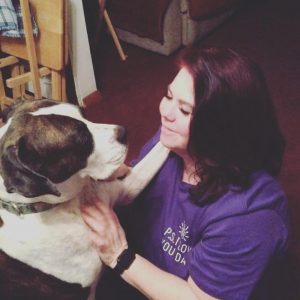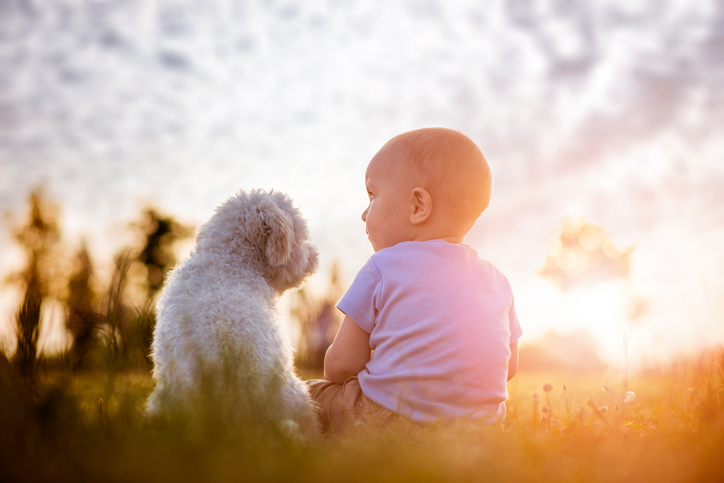by Katie McKnight, co-owner of International School For Certified Dog Trainers.
Imagine you settle into bed after a long day and drift to sleep. Moments later, a loud shriek awakens you. You bolt from bed and investigate the ghastly sound. In the corner of the room, something thrashes beneath a blanket. Frozen in place, you’re left with a decision: fight or flight?
Now, imagine the frightened character is your dog and the unknown creature is your newborn baby. Can we expect our canine friends to know the difference between a new family member and prey? The answer is no.
How do we prepare the dog for the new family member? In between prenatal visits and the baby shower, teach your pup basic obedience.
Basic Obedience
Before your baby is born, focus on leadership to ensure the pack is properly structured. Basic obedience training is a great place to begin. Once your dog learns basic commands such as sit, down, stay, come, leave it, off and place, reinforce these commands while cradling a realistic-looking doll. The exercise should include walking back and forth with the doll, simulating burping a baby, feeding it and sitting with the doll in your arms.
Once the dog is familiar with you cradling the doll, download recordings of a baby crying, gurgling, giggling, etc. and play the recording while you hold the doll. Gradually increase the volume of the recording with each lesson. The goal of this exercise is for the dog to remain relaxed during different scenarios. If the dog reacts poorly, move the dog further away from you and the doll and try again. When the dog is relaxed, gradually invite him to move closer and repeat the exercise.
After each training session, put the doll away in a safe place. Treat the doll the same way you would treat a real baby, so the dog knows it is not a toy.
Prohibit Jumping
Not only is jumping on people rude behavior, it can cause harm to your child. Discourage your dog from jumping, especially when someone is holding the doll. This way the dog exhibits proper behavior well before your baby arrives.
Discourage Bossy Behavior
It is important that you continue to make time for your dog after the baby’s arrival. If you can no longer go on daily walks or play in the yard, hire a dog walker to help. Dogs require mental stimulation and exercise to remain happy and healthy. It is good practice to interact with your dog while the baby is awake. Provide the dog with a special treat while the baby eats and speak to him while you care for the baby. While the baby is asleep, pay less attention to the dog. Take care of his basic needs, but limit playtime. This way he will look forward to the baby’s presence.
Curb bossy behavior. Let’s face it, sleep-deprived parents quickly lose patience with a dog that barks or paws them for attention. Dogs must learn to wait their turn. It is impossible for you to meet every need on his timeline.
Our baby is Off Limits to you
Over the years, we have heard people brag about their dog’s protective nature with the baby. They find it cute that the dog sleeps on the floor in the nursery guarding the crib. People laugh when the dog growls as family members approach the bassinet. This is not appropriate behavior. It is imperative that you communicate to your dog that the baby belongs to you and the dog must abide by your rules whenever the baby is around.
To help the dog understand the rules, the baby’s nursery should be off limits unless you invite him in. When you do allow him in the room, let him sniff around so he becomes accustomed to unfamiliar smells. After a reasonable amount of time, instruct the dog to leave the room.
 Preparing for the Homecoming
Preparing for the Homecoming
When you pack your bags for the upcoming hospital stay, include a T-shirt, blanket or burp cloth. Swaddle the baby in the item so it has both the baby’s scent, as well as your own. Ask a family member to bring that item home from the hospital. Invite the dog to sniff the item while they hold it. Then instruct the dog to move away. By doing so, you are communicating to your dog that the item is yours and he requires your permission to sniff it. This exercise helps the dog create respect for rules relating to the baby.
The day you bring your bundle of joy home, ask a family member to bring the dog for a long walk so he can release energy. It’s best the dog is not in the home when you arrive.
When Mom arrives home, she should greet the dog without the baby in the room. Slowly introduce the baby. Although he’s familiar with the baby’s scent, he may not be ready for the whole package.
The dog should be on leash when he meets your newborn. Speak to him in a calm manner and allow him time to adjust. If he remains calm, he may gradually move closer to the baby (on a loose leash). If the dog appears agitated, remove him from the room and try again later.
Dogs are social and want to spend time with their family members. The ‘place’ command enables the dog to remain in the same room as the family, by settling into a special, out-of-the-way location.
Ahhhh! What do you mean an infant grows into a toddler?
Just when your fur baby gets used to the newborn, she grows into a curious baby. In addition to teaching the baby to be gentle, play with your dog’s ears, paws and tail. Gently tug on his fur to get him used to a baby’s touch.
Remember, Dogs are Animals
Most dog owners love their dogs like children. It is easy to forget they are animals. Remember, animals think and act differently than humans. Therefore, you should never leave your dog and baby unattended. He could accidentally hurt the baby by jumping on them or becoming aroused by crying and unexpected movement.
Do not believe that only large breed dogs are a danger to your baby. Small and toy-sized dogs can seriously injury too.
Just because your dog enjoys the company of children does not mean he will welcome a newborn. Training your dog before the baby’s arrival, will prepare you for unpredictable behavior. Find all of your pet care services on Petworks.
About the Author:
 Katie McKnight lives on Long Island, with her husband and three sons. She is a Certified Dog Trainer and Certified in Canine Behavior. She works for Sublime K9 Dog Training in Wantagh, NY and co-owns ISCDT (International School For Certified Dog Trainers) with Jessica Freedman. Katie works with canine behaviors ranging from puppy manners to aggression. Her passion is training therapy dogs and finds great joy in watching graduates brighten the lives of people. Her current canine companion, Elsa, was born blind and lived half her life in a shelter environment due to the disability. Since adopting Elsa, she’s had the pleasure of training several visually impaired dogs and encourages everyone to adopt one special needs dog in their lifetime, because she feels it makes you a better person.
Katie McKnight lives on Long Island, with her husband and three sons. She is a Certified Dog Trainer and Certified in Canine Behavior. She works for Sublime K9 Dog Training in Wantagh, NY and co-owns ISCDT (International School For Certified Dog Trainers) with Jessica Freedman. Katie works with canine behaviors ranging from puppy manners to aggression. Her passion is training therapy dogs and finds great joy in watching graduates brighten the lives of people. Her current canine companion, Elsa, was born blind and lived half her life in a shelter environment due to the disability. Since adopting Elsa, she’s had the pleasure of training several visually impaired dogs and encourages everyone to adopt one special needs dog in their lifetime, because she feels it makes you a better person.


